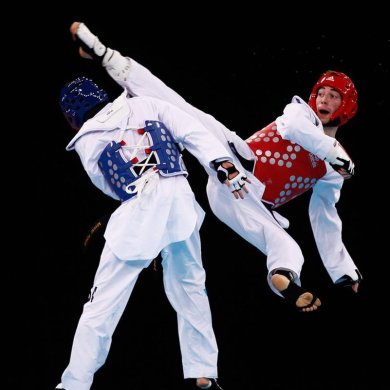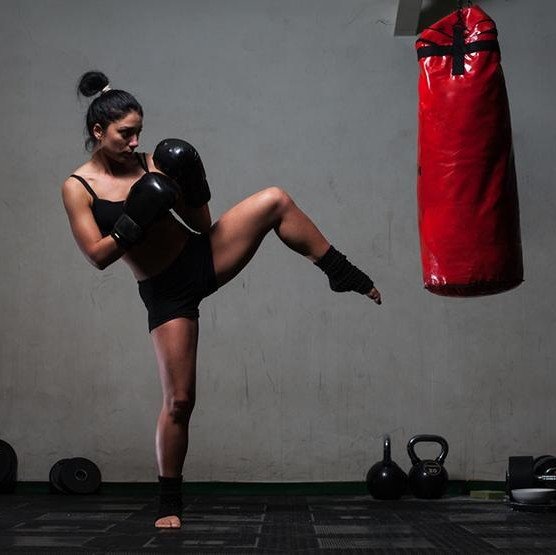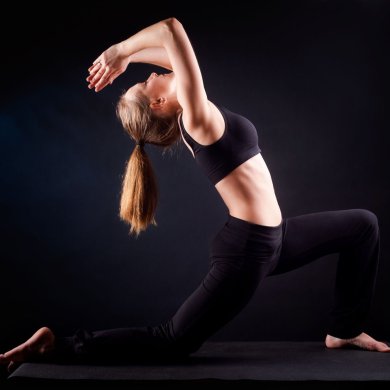Training
Enroll today for a better Future

KARATE
Karate, unarmed martial-arts discipline employing kicking, striking, and defensive blocking with arms and legs. Emphasis is on concentrating as much of the bodies power as possible at the point and instant of impact. Striking surfaces include the hands, ball of the foot, heel, forearm, knee, and elbow. All are toughened by practice blows against padded surfaces or wood. Pine boards up to several inches in thickness can be broken by the bare hand or foot of an expert. Timing, tactics, and spirit, however, are each considered at least as important as physical toughening. In sporting karate and sparring in training, blows and kicks are stopped short, preferably within an inch of contact. Sporting matches commonly last about three minutes, to a decision, if neither contestant has scored a clean killing point in the estimation of the judges.
the complexity:
Number of Classes
xx
Duration
xx

TAEKWONDO
Tae kwon do, Korean art of unarmed combat that is based on the earlier form of Korean self-defense known as tae kyon and on karate. Tae kwon do is characterized by the extensive use of high standing and jump kicks as well as punches and is practiced for sport, self-defense, and spiritual development. Training in tae kwon do is carried out by learning individual techniques of kicking, punching, and blocking, which are practiced in combined series of techniques in traditional sets known as hyung. Students also practice basic sparring combinations; these are short, set sequences of attack and counter practiced between partners, after which the students may practice free sparring as opponents. In sparring, blows are stopped just short of contact. Tae kwon do is practiced as a sport by awarding points to correctly executed techniques during free sparring or by judging the quality of performed hyung.
the complexity:
Number of Classes
xx
Duration
xx

KICKBOXING
Kick Boxing, sport, both amateur and professional, involving attack and defense with the fists. Boxers usually wear padded gloves and generally observe the code set forth in the marquess of Queensberry rules. Matched in weight and ability, boxing contestants try to land blows hard and often with their fists, each attempting to avoid the blows of the opponent. A boxer wins a match either by outscoring the opponent points can be tallied in several ways or by rendering the opponent incapable of continuing the match. Bouts range from 3 to 12 rounds, each round normally lasting three minutes.The terms pugilism and prizefighting in modern usage are practically synonymous with boxing, although the first term indicates the ancient origins of the sport in its derivation from the Latin pugil, a boxer, related to the Latin pugnus, fist, and derived in turn from the Greek pyx, with clenched fist.
the complexity:
Number of Classes
xx
Duration
xx

YOGA
Yoga, one of the six systems of Indian philosophy. Its influence has been widespread among Indian thought. Its basic text is the Yoga-sutras by Patanjali .The practical aspects of Yoga play a more important part than does its intellectual content, which is largely based on the philosophy of Samkhya, with the exception that Yoga assumes the existence of God, who is the model for the aspirant who seeks spiritual release. Yoga holds with Samkhya that the achievement of spiritual liberation occurs when the spirit is freed from the bondage of matter that has resulted from ignorance and illusion. The Samkhya view of the evolution of the world through identifiable stages leads Yoga to attempt to reverse this order, as it were, so that a person can increasingly dephenomenalize the self until it reenters its original state of purity and consciousness.
the complexity:
Number of Classes
xx
Duration
xx
